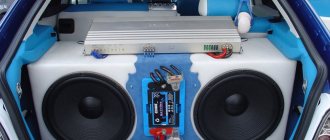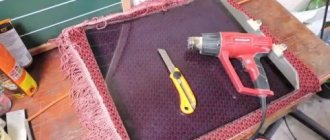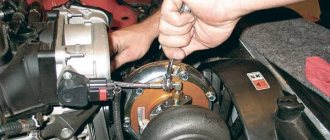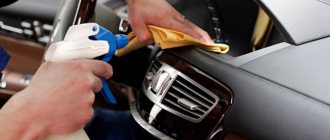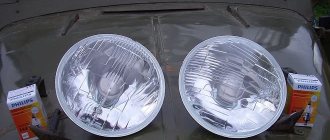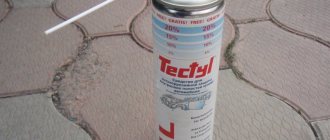Liquid glass is a unique material that can increase the level of body protection from mechanical damage several times. The choice of formulations on the market is very wide, but not all of them are of high quality. Our rating of the best brands of liquid glass will help you make your choice and not regret it.
Expert's choice:
| Model | Price |
| 1.Mr. Fix 9H | from 900 rub. |
| 2. Willson Body Glass Guard WS-01238 | from 2600 rub. |
| 3. Soft99 H-7 | from 6500 rub. |
| 4. Q2 Can Coat Gyeon GYQ200 | from 7000 rub. |
| 5. HENDLEX NC9 PRO SET+ | from 9500 rub. |
Mini rating
Liquid glass: what is it, why is it applied?
Liquid glass
Liquid glass is a special polymer composition that has high protective properties. Initially it was developed for the construction segment, but soon a beautiful side effect of the material was noticed - a mirror shine. Manufacturers took advantage of this, finalizing the formula and making it available for use in finishing residential/commercial real estate and tuning vehicles.
Liquid glass for cars is used to increase the durability of the paintwork. Factory processing remains flawless for an average of no more than three years. After this period, the driver has to put up with chips and scratches on the body or repaint the car. But it is quite possible to avoid unnecessary costs if you additionally fill the body with liquid polymers, which experts often call nanoceramics.
Advantages and disadvantages
repels water and dust
giving factory aesthetics
sparkling effect that cannot be achieved with conventional polishing
resistance to chemical reagents that are generously sprinkled on city streets and roads
reduction in sunburn
drivers will have to repeat the procedure regularly
need for special care - contactless washing
not available in all regions of Russia
Treatment with the composition has a lot of advantages:
- repels water and dust;
- giving factory aesthetics;
- sparkling effect, which cannot be achieved with conventional polishing;
- resistance to chemical reagents that are generously sprinkled on city streets and roads;
- reducing the degree of sunburn.
Important! In Russian realities, a nanocoating for a car body retains its properties for one and a half years. If you operate the car in gentle conditions, this period will last up to 3 years.
The coating has no significant disadvantages. But drivers will have to repeat the procedure regularly. This means that the cost item on it will become permanent. The disadvantages include the need for special care - contactless washing. It is not available in all regions of Russia. Therefore, before coating it is worth considering the washing procedure.
It is also necessary to use the composition with caution in regions with severe frosts. Lower temperatures lead to cracking of the coating.
Decent choice
Often, in order to restore the paintwork of a car body, they resort to polishing. However, such work requires considerable expenditure, both in time and in cost. Not every owner can afford this procedure. It may take approximately 3 months, if not more, to completely restore the coverage.
In addition, there are certain risks, since the final result depends entirely on the professionalism of the employee. You also cannot do without the appropriate equipment.
In the advantages above, the good hydrophobic properties of Silane Guard liquid glass from a Japanese company were mentioned, but in order to avoid misunderstandings, it is worth emphasizing once again that this will become possible after applying at least 3-4 layers of liquid glass. It is also necessary to visit the car wash at least once a month to maintain the hydrophobic effect.
Types of compositions for processing
Coating a car with liquid glass begins with choosing the desired composition. It is sold in stores as:
- pastes;
- liquids;
- polishes.
Based on application methods, ceramics are divided into:
- Professional . Apply only under special conditions and with the participation of professional equipment. The process is carried out by craftsmen with special skills. Such compounds are not suitable for filling the body yourself - the owner will simply ruin the car.
- Household . The product is easy to apply independently and does not require any special skills. The most common is one-component liquid glass - it is immediately ready for application. There are also two-component formulations on sale that require pre-mixing.
Important! Regular polishes are often sold labeled “liquid glass”. If you look closely at the description on the packaging, it will be obvious - manufacturers note that the polish has the effect of liquid glass, implying the formation of a noticeable gloss, and not an increase in protective properties.
Which liquid glass manufacturer to choose
Almost all manufacturers today produce decent products. Therefore, be guided only by your own preferences. But at the same time:
- do not neglect to study the composition - it must contain sodium or potassium;
- pay attention to the price - do not consider too expensive or cheap formulations;
- open the container and visually evaluate the product - potassium ones have a marshy tint and increased viscosity, but sodium ones are liquid in a gray tone.
Important! User reviews will help you get the most complete information about ceramics on your car. Special auto forums contain comments from those who have already tried products from different brands and formed their own opinion about them.
Nanoceramics or liquid glass for cars – which is better?
The choice of ceramics or liquid glass
Car owners do not see the difference between ceramics and liquid glass. In 90% of cases these terms are used as synonyms. But in fact there is a slight difference between them. And it consists of additional processing at high temperatures - under the influence of heat, ordinary liquid glass turns into ceramics.
If we compare both options, it should be noted that nanoceramics:
- has an ordered molecular structure;
- has increased strength;
- has good adhesion;
- lasts up to 2 years;
- stands out for its resistance to chemical and thermal influences;
- is above average.
In contrast, liquid glass has:
- chaotic molecular structure;
- more liquid consistency;
- affordable price;
- service life about a year;
- coupling only with metal.
Important! Summarizing the above, we can say that it is advisable to apply nanoceramics to premium cars that are operated in a gentle mode. Liquid glass is more suitable for the economy segment.
Do-it-yourself application of liquid glass on a car: instructions
Having found out how much it costs to cover a car with liquid glass, car owners most often decide to carry out the procedure themselves. Moreover, absolutely anyone can cope with the application.
Materials and tools
Traditionally, everything necessary for applying nanoceramics is included with the product:
- protective gloves;
- polishing device;
- mixing pipette;
- set of towels;
- sponges.
The composition itself is represented by a base liquid and a hardener.
If the purchased kit does not contain any of the above, you will have to purchase the necessary items additionally.
Body preparation
The preparatory procedure takes a little time. It is divided into 2 stages:
- car washing;
- subsequent degreasing.
To ensure that the composition lies evenly and adheres well to the surface, degrease only with white spirit diluted in a small amount of water. Other means are contraindicated. And degreasers with silicone can completely render the liquid glass coating useless - the composition simply cannot adhere to the metal.
How to properly apply liquid glass video
Polishing
Applying glass paint involves preliminary dividing the entire work area into small segments:
- apply the product to a small area;
- rub the liquid thoroughly;
- repeat the manipulations until the car is completely covered.
Before starting the process, create conditions of ideal cleanliness - the slightest speck of dust will become instantly noticeable on the body.
Drying the composition takes about 6-7 hours. But it takes 10-14 days until complete hardening. During this entire period, avoid getting water on the car.
Important! Take your time and apply as much product as you can rub in at once. Otherwise, parts of the body will harden at different rates, which will negatively affect the final result - you won’t get a smooth mirror surface.
Is it possible to speed up polishing and how?
Yes, this is possible. For these purposes, you will need a grinding machine with a special soft polishing attachment:
- work with it without haste, carefully going through every centimeter of the surface;
- do not press on the tool - this creates unnecessary heat in the body;
- start processing from the right wing or bumper.
Important! Some car owners use a screwdriver and a polishing attachment. But without skill, beginners with such a set risk not being able to apply liquid glass.
Precautions and a number of nuances
When working with liquid glass, you must be careful and avoid getting it on your skin. Silane polymers, solvent and hardener, which are included in the composition, have a harmful effect on the human body. Therefore, you should only work while wearing gloves (the products are usually included in the kit). If the product does get on your skin, you should immediately wipe the affected area and rinse with water.
If the car has been repainted, it is worth conducting a test to check how the paint reacts to the liquid product. The packaging should be stored strictly in an upright position, out of the reach of children and protected from fire. The temperature should not be higher than 0-40 °C.
How to care for liquid glass on a car
After applying nanoceramics, car care should be taken more seriously than usual. But it still won’t cause much trouble:
- protect the vehicle from washing for half a month after coating with nanoceramics;
- go only to contactless car washes;
- remember that chemical cleaners containing abrasives (even the smallest ones) are prohibited;
- Avoid powerful dryers, replace them with more traditional and gentle drying with warm air.
Ceramic coating is a widely available way to extend the life of your vehicle and maintain its beautiful aesthetics. Therefore, you should not save on liquid glass that protects your vehicle from chips, cracks, bacteria and dirt.
Liquid glass for cars video
Advantages of the new product
The great popularity of liquid glass is due to several advantages:
- Affordable price. This is the most important indicator for most car enthusiasts.
- Ease of use. Before use, just shake the bottle.
- Hydrophobic properties. The water-repellent and dirt-repellent effects are obvious, which is confirmed by many car owners.
- Protection. By strengthening it with silicon dioxide, the polymer film eliminates the appearance of small scratches that can usually occur when washing a car manually or mechanically.
- Effective durability. Correct use of Silane Guard liquid glass (at least 3 layers) allows the coating to withstand about 50 contactless body washes.
- Equipment. Everything you need is already contained in the kit, and you won’t have to buy anything extra.
- Bright appearance. Many car enthusiasts were amazed by the excellent result - the car really shines!
Typically, aggressive detergents are used when washing, which have a negative effect on the body enamel. In addition, under the pressure of water, small particles fall onto the surface, which destroy it over time. By wiping or polishing the body, car wash employees unknowingly damage the coating. The remaining solid particles from washing scratch the paint every time you wipe the cloth, causing serious damage.
Contactless washing can cause no less harm, since the chemicals, along with the dirt, remove some of the paint from the body coating, which leads to a loss of brightness. With the polish – liquid glass Silane Guard – you don’t have to worry about washing your car.

